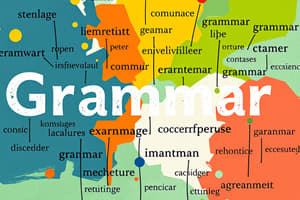Podcast
Questions and Answers
What involves both the ability to comprehend spoken and written words and to produce meaningful communication?
What involves both the ability to comprehend spoken and written words and to produce meaningful communication?
- Phoneme
- Language (correct)
- Syntax
- Morpheme
What is the smallest unit of sound that makes a meaningful difference in a language?
What is the smallest unit of sound that makes a meaningful difference in a language?
Phoneme
What explains why speakers of a particular language group a variety of sounds into a single phoneme?
What explains why speakers of a particular language group a variety of sounds into a single phoneme?
Categorical perception
What is a string of one or more phonemes that make up word meanings?
What is a string of one or more phonemes that make up word meanings?
What is the set of rules of a language by which we construct sentences?
What is the set of rules of a language by which we construct sentences?
What refers to the situation in which language is being used, including body language?
What refers to the situation in which language is being used, including body language?
Syntax is the smallest unit of meaning.
Syntax is the smallest unit of meaning.
What is the smallest unit of meaning?
What is the smallest unit of meaning?
What is the area of the brain responsible for language production?
What is the area of the brain responsible for language production?
What area of the brain is responsible for language comprehension?
What area of the brain is responsible for language comprehension?
What do infants begin making vowel sounds called by 6 to 8 weeks old?
What do infants begin making vowel sounds called by 6 to 8 weeks old?
What term refers to intentional vocalizations that lack specific meaning, typically occurring between 5 and 7 months?
What term refers to intentional vocalizations that lack specific meaning, typically occurring between 5 and 7 months?
What type of babbling involves simple consonant-vowel pairs that are repeated?
What type of babbling involves simple consonant-vowel pairs that are repeated?
What type of babbling occurs when the infant is between 8-10 months and involves complex sound combinations?
What type of babbling occurs when the infant is between 8-10 months and involves complex sound combinations?
What refers to the ability of speakers to compose sentences to represent new ideas?
What refers to the ability of speakers to compose sentences to represent new ideas?
Who proposed a theory that genes could code the basis of grammatical structure?
Who proposed a theory that genes could code the basis of grammatical structure?
What term did Chomsky use to describe the innate sensitivity that allows children to organize abstract categories of language?
What term did Chomsky use to describe the innate sensitivity that allows children to organize abstract categories of language?
What is the ability to speak two languages called?
What is the ability to speak two languages called?
Flashcards
Phoneme
Phoneme
The smallest sound unit in a language that creates meaningful differences. For example, the 'p' sound in "pat" is a phoneme, and changing it to 'b' in "bat" changes the word's meaning.
Categorical Perception
Categorical Perception
A method of perceiving sensory inputs and grouping them into a single category. For example, speakers of English might hear different sounds as the same phoneme, making distinctions difficult.
Morphemes
Morphemes
Composed of one or more phonemes, morphemes are crucial for word meanings. For example, adding the morpheme '-ing' to "walk" changes the word to "walking."
Syntax
Syntax
Signup and view all the flashcards
Contextual Information
Contextual Information
Signup and view all the flashcards
Broca Area
Broca Area
Signup and view all the flashcards
Wernicke Area
Wernicke Area
Signup and view all the flashcards
Cooing
Cooing
Signup and view all the flashcards
Babbling
Babbling
Signup and view all the flashcards
Repetitive Babbling
Repetitive Babbling
Signup and view all the flashcards
Variegated Babbling
Variegated Babbling
Signup and view all the flashcards
Generativity
Generativity
Signup and view all the flashcards
Chomsky's Theory of Language Acquisition
Chomsky's Theory of Language Acquisition
Signup and view all the flashcards
Language Acquisition Device (LAD)
Language Acquisition Device (LAD)
Signup and view all the flashcards
Bilingualism
Bilingualism
Signup and view all the flashcards
Study Notes
Language
- Comprehension of spoken/written words and production of meaningful communication is essential for language.
Phoneme
- Smallest sound unit in a language that creates meaningful differences.
- Phonemes correspond to alphabet letters, but not always in a one-to-one manner.
Categorical Perception
- A method of perceiving sensory inputs and grouping them into a single category.
- Speakers of a specific language often hear different sounds as the same phoneme, making distinctions difficult.
Morphemes
- Composed of one or more phonemes, crucial for word meanings.
- Altering a morpheme can change a word's meaning.
Syntax
- Rules governing sentence structure vary by language.
- English syntax requires a noun and a verb in every sentence, which can be modified by adjectives and adverbs.
Contextual Information
- The situational context, including prior interactions and body language, influences language interpretation.
- Example: The word "unbelievable" can mean positive or negative based on the context.
Broca Area
- Located in the left hemisphere near the motor cortex.
- Responsible for language production and historically studied by Paul Broca in the 1860s.
Wernicke Area
- Positioned next to the auditory cortex in the brain.
- Responsible for language comprehension.
Cooing
- Begins at 6 to 8 weeks; infants produce vowel sounds and varied cries to practice vocalization.
Babbling
- Starts between 5 to 7 months; includes intentional vocalizations of consonant and vowel combinations without specific meaning.
- Shows developing control over tongue movements with prolonged sound strings.
Repetitive Babbling
- Early babbling involves simple repeated consonant-vowel pairs (e.g., "guh-guh" or "ba-ba").
Variegated Babbling
- Occurs between 8 to 10 months; features complex sound combinations mixing different consonants and vowels (e.g., "ma-ba-guh").
Generativity
- Ability to create new sentences to express novel ideas not previously encountered.
Noam Chomsky's Theory of Language Acquisition
- Chomsky proposed that while words are learned through experience, genetic coding aids in perceiving grammatical structures.
- Infants are innately capable of identifying grammatical classes and word orders based on language exposure.
Language Acquisition Device (LAD)
- Chomsky's term for the innate capability that enables children to organize language's abstract categories.
Bilingualism
- The ability to fluently speak two languages.
Studying That Suits You
Use AI to generate personalized quizzes and flashcards to suit your learning preferences.




